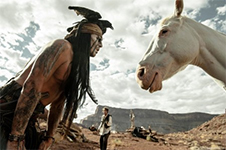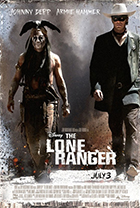The Lone Ranger (2013)
|  It doesn’t take long to get the sense that the makers of The Lone Ranger had no idea what to do with the title character, a significant problem for a film that is ostensibly, in the words of producer Jerry Bruckheimer, re-introducing the character “in a fresh and exciting way.” Originally created in 1938 to fill the programming needs of a radio station, the Lone Ranger has always been a square peg—an upright, upstanding, wholesome, morally unimpeachable, fundamentally decent hero who always does the right thing. One might rightfully ask if there is room for such an uncomplicated character at the multiplex these days, especially when the heroes of big-budget tentpole franchises tend to be tortured vigilantes (The Dark Knight), morally compromised narcissists (Iron Man), or quirky opportunists (Pirates of the Caribbean). The Lone Ranger is none of those things, and to pitch him into any kind of gray area would be to lose the essence of what his character is all about. It doesn’t take long to get the sense that the makers of The Lone Ranger had no idea what to do with the title character, a significant problem for a film that is ostensibly, in the words of producer Jerry Bruckheimer, re-introducing the character “in a fresh and exciting way.” Originally created in 1938 to fill the programming needs of a radio station, the Lone Ranger has always been a square peg—an upright, upstanding, wholesome, morally unimpeachable, fundamentally decent hero who always does the right thing. One might rightfully ask if there is room for such an uncomplicated character at the multiplex these days, especially when the heroes of big-budget tentpole franchises tend to be tortured vigilantes (The Dark Knight), morally compromised narcissists (Iron Man), or quirky opportunists (Pirates of the Caribbean). The Lone Ranger is none of those things, and to pitch him into any kind of gray area would be to lose the essence of what his character is all about.Thus, at a loss for what to do, director Gore Verbinski and screenwriters Justin Haythe, Ted Elliott, and Terry Rossio (the latter two having collaborated with Verbinski on the first three Pirates movies) take the low road by making the character into a doofus. Stuck with a character they can’t really transform or darken to meet the tenor of our times, they instead spend much of the movie making fun of him, turning him into a galloping joke in a white hat and black mask, which makes it extraordinarily difficult to care about his exploits, no matter how inventively staged they might be. Armie Hammer, who played the Winklevoss twins in The Social Network (2009) and Hoover’s “constant companion” in J. Edgar (2010), seems torn, as if he isn’t sure whether he should be playing the Lone Ranger as the straight man in a wild west comedy or playing him with a knowing wink (one wonders if anyone let him in on the joke). As a result, the character never gels; he’s as scattered as the movie itself, all two and a half lumbering hours of it. Rather than being a Texas Ranger, the filmmakers reimagine Lone Ranger-to-be John Reid as a stiff, East Coast-educated lawyer returning to the open wilds of post-Civil War Texas, which allows them to maintain his inherent do-gooderism by emphasizing his adherence to the law and proper protocol (when first handed a gun, he pushes it away and professes, “I don’t believe in them”). Far from being a Batman-style vigilante, he wants to put the bad guys behind bars by following the letter of the law and thus proving that civility and order will always trump chaos. Of course, such an outlook doesn’t really work in the Wild West, and when he is shot down along with a team of Texas Rangers that include his macho older brother Dan (James Badge Dale), he must recreate himself as the Lone Ranger to fight the good fight. The problem is that his transformation never really happens; he remains a goofball, albeit one who eventually embraces a six-shooter and, when the plot needs him to, performs heroic and spectacular physical fears in the name of justice. His supposed transformation takes place under the aegis of Tonto (Johnny Depp), his Native American partner who in previous iterations would have been referred to as his “sidekick” but is here presented, for revisionist purposes, I assume, as a more fully formed and interesting character—much more interesting, it turns out, than his “kemosabe.” It isn’t hard to see that the filmmakers were hoping that Depp would make Tonto into the next Jack Sparrow—an unexpectedly humorous and engaging character who steals every scene he’s in—but it turns out that the material is beyond Depp’s grasp, as well. Donning cracked white and black make-up and a headdress with a stuffed crow that he constantly feeds, Depp certainly takes an offbeat approach to an otherwise familiar character, and the one thing the screenplay does well is suggest that Tonto is a kind of tortured soul, an outcast from his own tribe who may be a visionary shaman, a conman, a madman, or some combination. Without anything interesting to do with the Lone Ranger, the filmmakers focus instead on Tonto, but the imbalance keeps the characters from forging any kind of a bond. The whole film is really a glorified origin story, and at the end the Lone Ranger and Tonto are supposed to fully embrace each other as partners, but they have no real chemistry or connection. Tonto remains consistently above it all, which Depp emphasizes during the action sequence by appropriating a Buster Keaton-esque stone face, even when dangling precariously between two trains hurtling down a mountain. The filmmakers surely patted themselves on the back for their ethnically sensitive revisionism, moving the Native American character front and center while pushing the white hero to the background as a kind of bumbling accomplice (try counting the number of times the phrase “stupid white man” is used), but that work was done years ago, back in 1956, in fact, with the first feature-length Lone Ranger movie, which portrayed Native American culture as both dignified and socially complicated. Interestingly, the screenplay for Verbinski’s The Lone Ranger borrows an important plot element from that earlier film, namely the ploy of a scheming capitalist (in this case, a railroad company tycoon played by Tom Wilkinson) to enrich himself by creating false conflict between white settlers and Native Americans. Thus, any sense of political progressivism that might be found is old hat, just warmed over ideas from the cinema of the Eisenhower era. Of course, the earlier film didn’t have the radical tonal shifts that Verbinski’s film does, jerking us from scenes of gruesome violence (at one point, the villainous outlaw Butch Cavendish, played with greasy delight by William Fichtner, cuts out a character’s heart and eats it), to goofy comedy, to large-scale action, including a multi-train-chase climax in which the famous “William Tell Overture” is finally brought out in all its glory. As he did in Rango (2009), his oddball animated ode to spaghetti westerns, Verbinski wants to channel all of his favorite westerns, and we get touches of everything from John Ford (cue Monument Valley) to Sam Peckinpah (cue the whole-sale machine-gun slaughter of dozens of people). In Rango it worked because the film was better calculated in its weirdness, whereas The Lone Ranger just feels desperate, throwing everything at the screen and hoping something, anything sticks. In the final moments, when the Ranger finally gets to cry out his signature “Hi-yo Silver, away!,” Tonto dismisses the cheesiness with a stern, “Don’t ever do that again.” Something tells me he isn’t going to get the opportunity to do so, at least not any time soon. Copyright ©2013 James Kendrick Thoughts? E-mail James Kendrick All images copyright © Walt Disney Pictures |
Overall Rating: 
 (1.5)
(1.5)


